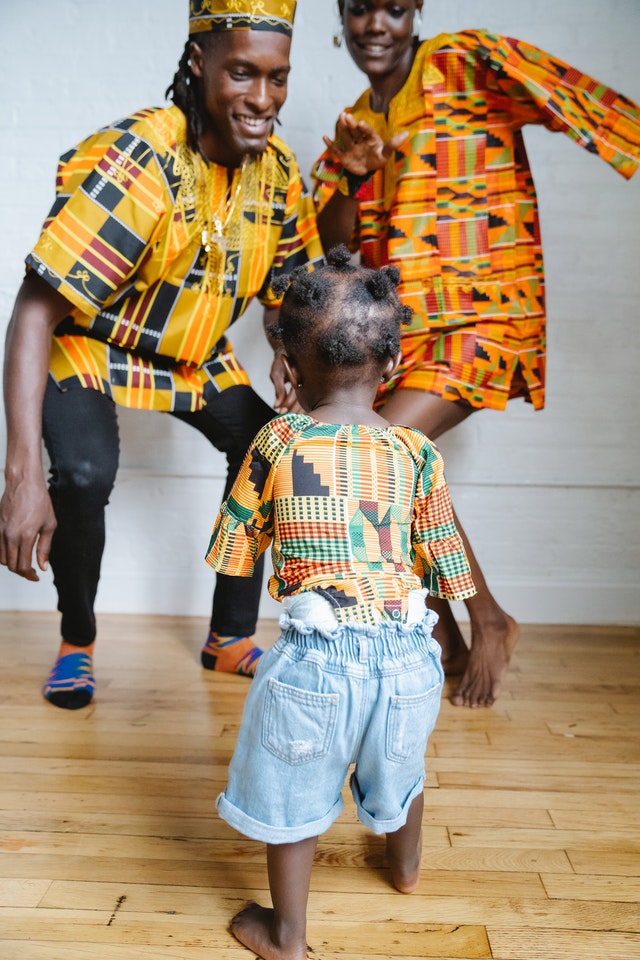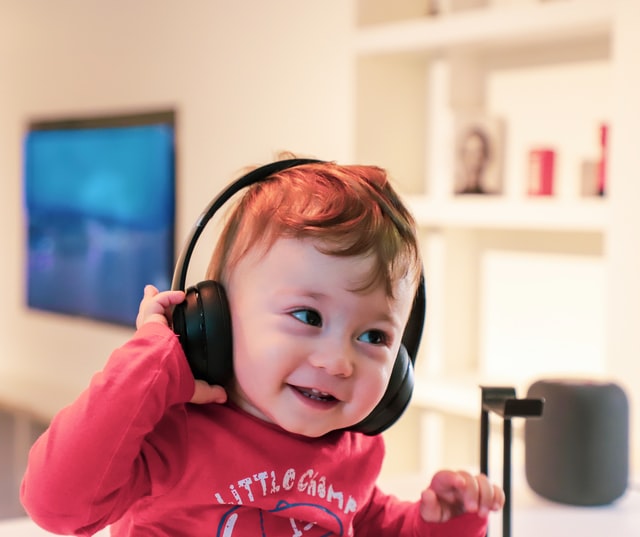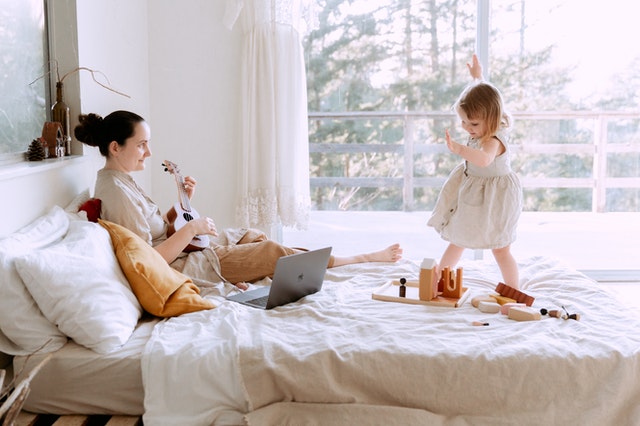Music is culturally universal; we all have versions of songs that we use to connect, communicate, and bond. They vary by style, but the one commonality is that they exist for the same purpose. Now, let’s be clear, you do not have to be a talented musician or even own an instrument to benefit from the tips in this article! Bringing music into your home can exist at any level, and we’ll talk about how to incorporate it in whatever way is accessible and fun for you and your loved ones. So let’s help you have some fun musical moments at home.
Why Do Music Activities at Home?

These days our lives seem to be more faster-paced than ever. We habitually run from one activity to the next, and often our houses can become more of a transit hub than a home. Bringing music into your home environment is an incredible way to get yourself into the present and destress. You can bring music to your home on your own or with the help of an expert like a piano teacher.
Music helps our brains to remain healthy and increases neuroplasticity -our brains’ ability to continue developing new neural pathways. Music keeps our brains active as we age and helps younger minds to establish strong and healthy connections.
Memories can be intensely tied to music. Using this knowledge intentionally can help you create rich memories of celebratory moments, milestones, or happy memories tied to a specific song.
The Benefits That Music Can Bring to Your Home
Creating a culture of love for music will most likely bring great things to your home. Music inspires creativity and it helps develop cognitive skills. It can help create moments in time that are separated from the stresses of life. They can be tools to create bonding and reflection. Music can be used for education and life experience lessons. Music has been known to:
- It helps to alleviate stress. Music has been shown to relieve stress by triggering biochemical stress reducers, according to research.
- It improves one’s mood. The hormone dopamine is produced in the brain in response to music. An increase in dopamine production can help alleviate anxiety and depression. The amygdala, the part of the brain involved in mood and emotions, processes music directly.
- It is a pain reliever. In geriatric care, intensive care, and palliative medicine, music can significantly reduce the perceived intensity of pain.
Pique Their Curiosity!
It might feel like the opposite of relaxing to bring another activity into your life, but the music at home differs from a scheduled activity while also being educational. As people, we are drawn to music. Even if you’re not a natural virtuoso or even interested in learning an instrument at all, we tend to gravitate towards music.
See what happens in your home if you start playing or making music while your family buzzes around, doing their regular activities. Play a chord or two, bang a pot, find something that shakes (pro tip – raid your laundry room. If you use dryer beads, give those a shake!), or put on a song that everyone likes and start singing along. Before long, you’ll have a crowd curiously peering in to see what all the commotion is about. Not long after that, you might hear an accompanying voice or a new percussion element joining into your impromptu musical breakout. It’s not planned, structured, or mandatory, making it a different kind of fun to add to your home life. Try some of the activities below in your home and see how much texture music can bring to your family’s day-to-day life.
Music Activities for Families

Just for fun – This might be the simplest one to execute – have a dance party. Throw on something lively and fun that your kids know to get them into the groove, and be prepared to set an example if this is a different kind of activity for your family. Your kids might not have seen you as the kind of person that would have a dance party! That’s okay, life is busy, and responsibilities are heavy; you have all the valid reasons in the world not to have been able to make time for dance parties. But, that might mean that you have to work through a bit of surprise and tentativeness on their part to get them to join in, especially if they’re older. Teen years are an embarrassing time just overall; never mind when you try to be a hip or fun dancing parent, persevere, and you’ll show your kids, no matter their age, that it’s okay to be silly and dance and enjoy music.
Learn with music – Music can be a fantastic source of learning new words. For older children, introduce them to a new song with ideas or phrases that they don’t know. Think Billy Joel’s “We Didn’t Start The Fire,” or talk about the 1950’s civil rights movements in comparison to today’s with Harry Belafonte’s “Day-O.” Just be prepared to do your homework first!
Connect with music – Bonding with your family via music can come in many different ways. If incorporating music is new for your kiddos and you, start simply listening to each other’s music types and getting your kids to explain to you why they like what they like. You’ll learn more about them, hear their stories, and that will help you connect. You can even find out if they want to be a Rock Star someday or be a part of a World-renowned orchestra. You can discover if there is an instrument they would like to learn to play, like the piano. Then you can consider taking piano lessons with your whole family to connect even further.
Once you have music established in your home, try making a song altogether! It doesn’t mean you need to have any instruments – make your own, or improvise from things around your house. Get creative; it’s part of the fun. Each family member can have their role, and together, you’ll make something unique and collaborative.
You don’t have to do anything with your song, but if you’re looking for a way to keep it alive, try recording it and playing it during family dinners or holidays. It’s a great way to stay warm and have happy memories alive.
Music Activities for Babies
Face gestures– A baby’s field of vision is only 30cm at this age, and they prefer faces to almost anything else. Songs in which you stick your tongue out or make funny faces will be fascinating to them. Light music is perfect for when they are newborns
Toes and finger awareness- It’s time for some captivating tunes, rhymes, and songs with intriguing endings! Tickling is a plus in this activity. This is great for under six months.
Try: “boom boom boom the baby goes weee! One, two, three I love you and me.!”
Peekaboo- Object Permanence, it’s time to help them understand that objects still exist even if you can’t see them.
Try: ¨Peekaboo, Peekaboo, Peekaboo, Peekaboo, Peekaboo, Peekaboo, I see you.¨ while doing thee hand gestures over your face.
Music Activities for Young Children

Just for fun – Play a game called ‘Freeze Dance’ with your little one. It’s as simple as it sounds and can be done with you or as an activity that you can oversee while doing other things (but it’s more fun for you if you play, too). Play some of your little dancers’ favorite tunes while they dance, and then pause the music and yell, “Freeze!” and get them to stop exactly where they are. Take pictures of funny poses for them to see and show off later.
Learn with music – If your children are younger and learning many new words, ask them questions like “What are three songs that have the word ______ in them?”. You can adjust this based on their vocabulary and make the words harder as they learn. This is a great activity to try out.
Connect with music – Your kiddos are used to you being the leader, so flip the script for this one, and you follow their lead. Depending on their personality, they might love it right off the bat or be a bit shy at first, but it’s a great way to show them that you’re open to their ideas and build their confidence by using music therapy.
Music Activities for Teens

Get creative – Bring music and art together by having a musical painting night! This is a great activity to do with your teen or let them do solo. Have them choose their favorite song and paint something that matches the song’s theme. If you’re doing this creative activity together, paint something yourself that matches their song choice, even if you don’t enjoy their style of music. It’s a great way to show that you’re open to learning more about them and what they like.
Confidence is key – Dance parties for the win. Music brings a rush of dopamine, as does exercise. Get your teen moving their bodies and bumping their heart rates, and you’ll see self-consciousness start to slide away. Depending on how outgoing your teen is, you might need to work into this one slowly. Showing them that their bodies look or move is fun, and okay, and a source of happiness will help boost their overall confidence.
Connect with music – This is a good one for commutes with your teen. Think of a song that brings a happy memory for you that you can tell them a story about. Ask them on your ride if you can play a song that makes you happy because you want to share it with them and see how much conversation opens up. Then flip it and ask them to think of a song they want to share with you. If they need some time to think, remind them on the next trip. Music is so connected to memories that exchanging stories connected to music provides powerful insight for both of you regarding how the other processes and prioritizes the world.
Music Activities for The Parents

Just chill – Take turns DJing when you’re doing household chores and see how much more pleasant daily tasks become. Plus, you learn more about your partner’s musical preferences the more regularly do this, which leads to new avenues for conversation and knowledge. Music can also increase productivity, so you might find that your chore time was more fun and shorter!
Connect with music – Plan date nights out together that involve live music when it’s possible. Music adds so much depth to our experiences together; you’ll find that these memories are richer, more detailed, and rooted in the shared happiness that music brings.
Karaoke is a popular pastime for a good reason – it might be cringy and cheesy, but it’s really, really fun. Throw your insecurities to the side and show your partner that you’re there to have fun and laugh with them. Being silly and showing your less serious side is a powerful way to connect, even if it comes with an embarrassing moment or two!
Musical Moments at Home is a Great Idea!

Think about it. Music threads its way into our lives all the time. It’s a central feature of movies, sports, family events, and world events. It is because it pulls on our emotions even if we don’t consciously notice. If you don’t think of yourself as a musical person by nature, you might need to consider how music has affected your life experience. If you take this creative idea into your home, you’ll notice all kinds of benefits like uplifting mood changes, new avenues to teach and learn about the world with your kids and family, and more ways to bond and connect. There is a reason music is culturally universal!
